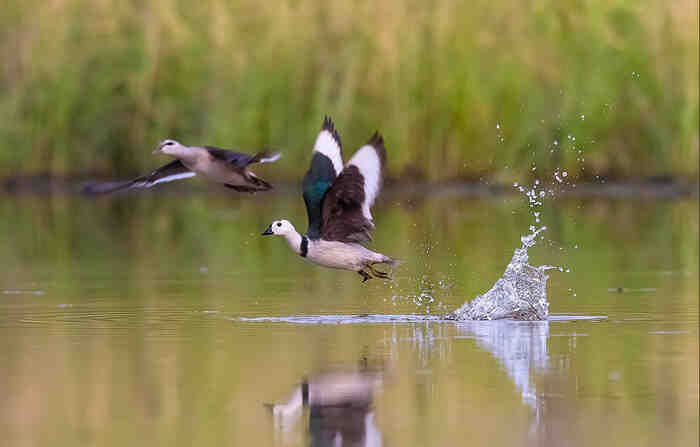Nettapus coromandelianus
IUCN
LCBasic Information
Scientific classification
- name:Nettapus coromandelianus
- Scientific Name:Cotton duck, white duck, eight duck, cotton duck,Nettapus coromandelianus,Cotton Pygmy-goose
- Outline:Waterfowl
- Family:Aneniformes Anatidae Gossypius
Vital signs
- length:About 30 cm
- Weight:190-312g
- lifetime:No textual research information is available
Feature
Cotton lapwing elected Chengdu Bird of the Year 2021.
Distribution and Habitat
It is mainly distributed in China, India, Sri Lanka, Bangladesh, Myanmar, Thailand, Indochina Peninsula, Indonesia, Malaysia and northeastern Australia.
In China, it is a resident bird in Guangdong and Guangxi, a lost bird in Taiwan, and a summer migratory bird in other places. It is distributed in the following protected areas: Wuyi Mountain (Fujian), Neilingding Island -- Futian, Dongzhai Port Mangrove, Jianfeng Mountain, Dongzhai Birds, Jigong Mountain, East Dongting Lake, Poyang Lake, Poyang Lake, Wuyi Mountain (Jiangxi), Wuliang Suhai wetland birds, Wuliang Suhai wetland birds.
It lives in rivers, lakes, ponds and swamps, especially in open water rich in aquatic plants. It is also sometimes found in small ponds and canals near villages.
Appearance
The male bird has a white forehead, dark brown on the forehead and crown, white on the rest of the head and neck, and a wide black and shiny green collar at the base of the neck. The shoulder, waist and upper wing coverings are black brown with metallic green flash, especially the large coverings with green metal flash; The primary feathers are black brown, the middle of each feather is white, forming a large white wing spot, the secondary feathers are black brown, with green luster and white end spots; Tertiary feathers black brown, slightly purple-blue luster; White cover on tail and two flanks. It has black fineness spots, dark brown tail feathers, with insignificant green metallic luster, light brown feather margin, dark brown axillary feathers and underwing coverts; Undercaudal coverts white with brown tip spots, rest underbody white.
The female has dark brown forehead and crown, mixed with white on the forehead, white on the brow, black across the eye, light brown on the nape,
Details
There are two subspecies of Cotton Pygomy-goose.

They often live in pairs or in small groups of a few to more than 20 individuals. Sex is more docile. Good swimmer, also good diver, but generally rarely diving. They usually spend most of their time in the water, not going ashore, but sometimes climbing on trees or other objects protruding from the water. When frightened, it can immediately rush out of the water and fly, take off quickly and flexibly, and constantly issue a "cluck" call. Usually does not fly high, the two wings incitement amplitude is small, the flight distance is not large, but the flight speed is faster. It is mainly active during the day, and it lives on lakes or branches at night.
It feeds mainly on buds, leaves and roots of aquatic and terrestrial plants, as well as aquatic insects, worms, snails, mollusks, crustaceans and small fish. Foraging activities during the day, often in the surface and shore shallow water to feed, rarely diving to hunt.
The breeding season is from May to August. They often form small groups before breeding, and pairs during breeding. Nests are built in tree holes not far from the water, also seen in camphor tree holes in front of the house and willow tree holes by the pool, and even in abandoned chimneys. Each clutch lays 8-14 eggs, is white in color, 38-47×29-36 mm in size, averaging 75×33 mm, and weighs 27 grams. The female incubates her eggs and the male keeps watch near the nest. Incubation period is 15-16 days. Breed one to two litters a year.
The number of cotton lapwing is rare in China, and measures should be taken to strengthen wetland management and prohibit hunting and egg collecting during breeding period to protect it.
In June 2022, "Eifeng Mountain people", a member of Quanzhou bird watching Society, found the cotton lapwing, a national second-class protected animal, while watching birds in the field of ninety-nine streams in Jinjiang. This is the first time that the bird appeared in Quanzhou, and it also set a new record for the bird species in Quanzhou - so far, a total of 331 bird species have been recorded in Quanzhou.
On June 9, 2022, Mian Fu appeared in the Big Mianchi Lake District, Duchang County, Poyang Lake.
In June 2022, there are photographers in Yuxi City, Jiangchuan District, Xingyun Lake east bank Wetland Park photographed the national second-class key protected animals cotton teal, this is their first appearance in Xingyun Lake. In June of the same year, the rare bird cotton Fu appeared in Shuangguihu National Wetland Park, Liangping District, Chongqing. On July 31, the cotton lapwing appeared in the shoal of Lugou Bridge section of Yongding River in Beijing, which is the first time that the cotton lapwing appeared in Fengtai, Beijing.
It was included in the List of Land Wild Animals under State Protection that are beneficial or have important economic and scientific research value (Item 65) issued by the State Forestry Administration of China on August 1, 2000.
Listed in the International Union for Conservation of Nature Red List of Threatened Species (IUCN) for 2016 ver 3.1 - Not Threatened (LC).
Listed in China's "National Key Protected Wildlife List" (February 5, 2021) Level 2.
Protect wild animals and eliminate wild meat.
Maintaining ecological balance is everyone's responsibility!








